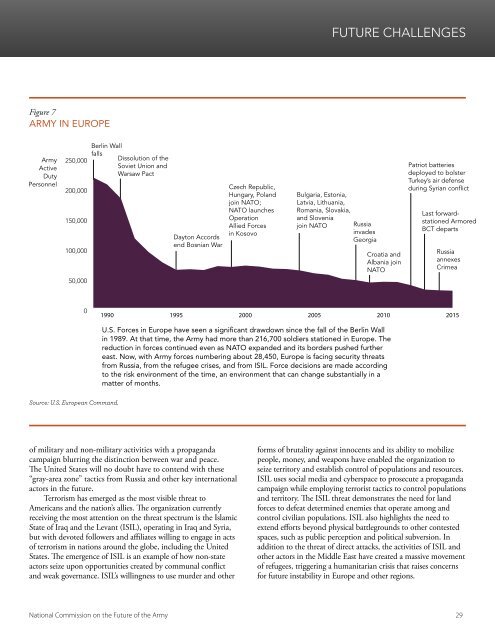THE FUTURE OF THE ARMY
Futurearmy
Futurearmy
Create successful ePaper yourself
Turn your PDF publications into a flip-book with our unique Google optimized e-Paper software.
<strong>FUTURE</strong> CHALLENGES<br />
Figure 7<br />
<strong>ARMY</strong> IN EUROPE<br />
Army<br />
Active<br />
Duty<br />
Personnel<br />
250,000<br />
200,000<br />
150,000<br />
100,000<br />
Berlin Wall<br />
falls<br />
Dissolution of the<br />
Soviet Union and<br />
Warsaw Pact<br />
Dayton Accords<br />
end Bosnian War<br />
Czech Republic,<br />
Hungary, Poland<br />
join NATO;<br />
NATO launches<br />
Operation<br />
Allied Forces<br />
in Kosovo<br />
Bulgaria, Estonia,<br />
Latvia, Lithuania,<br />
Romania, Slovakia,<br />
and Slovenia<br />
join NATO Russia<br />
invades<br />
Georgia<br />
Croatia and<br />
Albania join<br />
NATO<br />
Patriot batteries<br />
deployed to bolster<br />
Turkey’s air defense<br />
during Syrian conflict<br />
Last forwardstationed<br />
Armored<br />
BCT departs<br />
Russia<br />
annexes<br />
Crimea<br />
50,000<br />
0<br />
1990<br />
1995<br />
2000<br />
2005<br />
2010<br />
2015<br />
U.S. Forces in Europe have seen a significant drawdown since the fall of the Berlin Wall<br />
in 1989. At that time, the Army had more than 216,700 soldiers stationed in Europe. The<br />
reduction in forces continued even as NATO expanded and its borders pushed further<br />
east. Now, with Army forces numbering about 28,450, Europe is facing security threats<br />
from Russia, from the refugee crises, and from ISIL. Force decisions are made according<br />
to the risk environment of the time, an environment that can change substantially in a<br />
matter of months.<br />
Source: U.S. European Command.<br />
of military and non-military activities with a propaganda<br />
campaign blurring the distinction between war and peace.<br />
The United States will no doubt have to contend with these<br />
“gray-area zone” tactics from Russia and other key international<br />
actors in the future.<br />
Terrorism has emerged as the most visible threat to<br />
Americans and the nation’s allies. The organization currently<br />
receiving the most attention on the threat spectrum is the Islamic<br />
State of Iraq and the Levant (ISIL), operating in Iraq and Syria,<br />
but with devoted followers and affiliates willing to engage in acts<br />
of terrorism in nations around the globe, including the United<br />
States. The emergence of ISIL is an example of how non-state<br />
actors seize upon opportunities created by communal conflict<br />
and weak governance. ISIL’s willingness to use murder and other<br />
forms of brutality against innocents and its ability to mobilize<br />
people, money, and weapons have enabled the organization to<br />
seize territory and establish control of populations and resources.<br />
ISIL uses social media and cyberspace to prosecute a propaganda<br />
campaign while employing terrorist tactics to control populations<br />
and territory. The ISIL threat demonstrates the need for land<br />
forces to defeat determined enemies that operate among and<br />
control civilian populations. ISIL also highlights the need to<br />
extend efforts beyond physical battlegrounds to other contested<br />
spaces, such as public perception and political subversion. In<br />
addition to the threat of direct attacks, the activities of ISIL and<br />
other actors in the Middle East have created a massive movement<br />
of refugees, triggering a humanitarian crisis that raises concerns<br />
for future instability in Europe and other regions.<br />
National Commission on the Future of the Army 29


